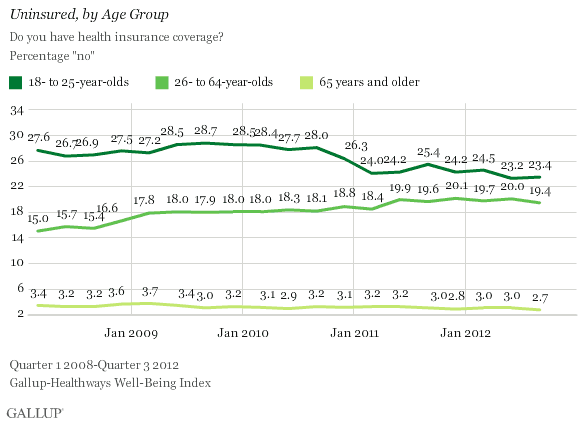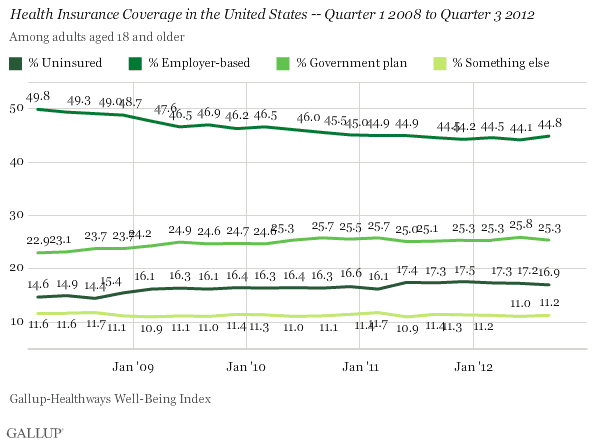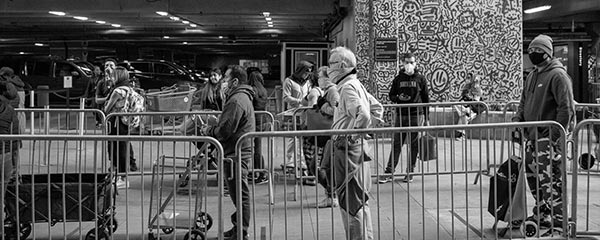WASHINGTON, D.C. -- Fewer 18- to 25-year-old Americans are uninsured in the third quarter of 2012 than in past years, with the 23.4% now lacking coverage down from a high of 28.7% in the third quarter of 2009. But, at 19.4%, the percentage of uninsured 26- to 64-year-olds is still trending higher.

Gallup and Healthways initially picked up a decline in the uninsured rate for 18- to 25-year-olds in the fourth quarter of 2010, when it fell to 26.3% -- from 28.0% in the third quarter of that year -- after the healthcare law provision allowing Americans up to age 26 to remain on their parents' plans went into effect. The rate declined further to 24% in the first quarter of 2011 and stayed at about that level for some time before inching down slightly to the 23% range in the second and third quarters of 2012.
At the same time, 26- to 64-year-olds have become more likely to be uninsured, with the percentage lacking coverage now at 19.4%, up from 15% in January 2008, when Gallup and Healthways first started tracking Americans' health insurance coverage. This reflects a combination of higher unemployment and reduced benefits for those who are employed.
The 2.7% of seniors who were uninsured in the third quarter of 2012 is the lowest Gallup has found, but is statistically similar to the rates recorded over the past four years. This stability is due to the large majority of seniors qualifying for Medicare.
About 17% of All U.S. Adults Remain Uninsured; Employer-Based Coverage Still Down
The percentage of all U.S. adults who are uninsured was 16.9% in the third quarter of 2012, similar to levels recorded over the past year. However, more Americans are uninsured now than were from 2008 through 2010.
Slightly more Americans reported getting their health insurance through an employer last quarter, at 44.8% -- this is still down, though, from the high of 49.8% found in January 2008.
About one-quarter of Americans continue to get their health coverage through Medicare, Medicaid, or military/veterans' benefits, slightly higher than in 2008 and 2009. Another 11% get their coverage through "something else," which could mean they purchase it themselves.

The increase in the percentage of all Americans who were uninsured in the second quarter of 2011 coincides with Gallup's decision to include more cellphone-only respondents in the U.S. beginning April 1. Thus, some of the increase in the uninsured could reflect the greater representation of cellphone-only respondents -- who tend to be younger -- in Gallup samples.
Bottom Line
It remains clear that the 2010 Affordable Care Act is having a significant impact on young adults. Fewer Americans aged 18 to 25 lack health insurance now than did before the provision in the law allowing those up to age 26 to stay on the their parents' plans went into effect in September 2010. However, Americans aged 26 to 64 have yet to benefit from the law in a major way, which is because the main components of it -- the individual mandate and insurance exchanges -- don't go into effect until 2014.
About the Gallup-Healthways Well-Being Index
The Gallup-Healthways Well-Being Index tracks well-being in the U.S., U.K., and Germany and provides best-in-class solutions for a healthier world. To learn more, please visit well-beingindex.com.
Survey Methods
Results are based on telephone interviews conducted as part of the Gallup-Healthways Well-Being Index survey July 1-Sept. 31, 2012, with a random sample of 90,998 adults, aged 18 and older, living in all 50 U.S. states and the District of Columbia, selected using random-digit-dial sampling.
For results based on the total sample of national adults, one can say with 95% confidence that the maximum margin of sampling error is ±1 percentage point.
Interviews are conducted with respondents on landline telephones and cellular phones, with interviews conducted in Spanish for respondents who are primarily Spanish-speaking. Each sample includes a minimum quota of 400 cellphone respondents and 600 landline respondents per 1,000 national adults, with additional minimum quotas among landline respondents by region. Landline telephone numbers are chosen at random among listed telephone numbers. Cellphone numbers are selected using random-digit-dial methods. Landline respondents are chosen at random within each household on the basis of which member had the most recent birthday.
Samples are weighted by gender, age, race, Hispanic ethnicity, education, region, adults in the household, and phone status (cellphone only/landline only/both, cellphone mostly, and having an unlisted landline number). Demographic weighting targets are based on the March 2011 Current Population Survey figures for the aged 18 and older non-institutionalized population living in U.S. telephone households. All reported margins of sampling error include the computed design effects for weighting and sample design.
In addition to sampling error, question wording and practical difficulties in conducting surveys can introduce error or bias into the findings of public opinion polls.
For more details on Gallup's polling methodology, visit www.gallup.com.In addition to sampling error, question wording and practical difficulties in conducting surveys can introduce error or bias into the findings of public opinion polls.
For more details on Gallup's polling methodology, visit https://www.gallup.com/.
